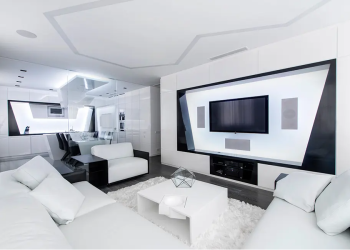Introduction
Pattern mixing is an art form that can elevate the ambiance of any living space, injecting personality and vibrancy into home decor. In the realm of interior design, embracing bold patterns is akin to painting a canvas with strokes of creativity. This article delves into the nuances of mixing patterns, offering insightful tips and guidelines for those seeking to infuse their homes with eclectic charm.
Understanding Patterns
Patterns are the visual elements that define the character of a space. From classic stripes to intricate florals, each pattern exudes its own unique energy. Understanding the psychology behind patterns is crucial; for instance, bold geometric designs may evoke a sense of modernity and dynamism, while soft, flowing motifs can impart a feeling of tranquility.
Principles of Mixing Patterns
Successful pattern mixing hinges on a delicate balance of scale, proportion, and color coordination. A harmonious blend of patterns can transform a room into a cohesive tapestry of visual delight. When selecting patterns, consider their respective scales – mixing large-scale patterns with smaller ones creates visual interest without overwhelming the space.
Choosing Patterns
Begin by identifying the dominant pattern, which serves as the focal point of the room. This could be a bold floral wallpaper or a striking geometric rug. Once the dominant pattern is established, select accent patterns that complement its colors or theme. Harmonizing patterns through shared hues ensures a cohesive look that feels intentional and well-curated.
Layering Patterns
Layering patterns adds depth and dimension to a room, infusing it with personality and charm. Experiment with mixing different scales of patterns – pair a bold, oversized print with a subtle, understated motif for visual balance. Avoid overcrowding the space with busy patterns; instead, aim for a harmonious blend that allows each pattern to shine.
Furniture and Textiles
Patterned upholstery and curtains offer an opportunity to infuse personality into your furniture pieces. Opt for statement-making fabrics that reflect your personal style, whether it’s a vibrant floral sofa or a geometric-printed armchair. Complement these larger pieces with patterned rugs and throw pillows to tie the room together.
Wall Treatments
Wallpaper is a powerful tool for adding pattern and texture to a space. Choose wallpapers with bold motifs to create a statement wall that anchors the room. Alternatively, opt for subtler patterns to add depth without overwhelming the space. Remember to consider the scale of the room when selecting wallpaper – larger patterns may overpower smaller rooms, while smaller patterns may get lost in larger spaces.
Accessories and Decor
Accessorizing with patterned decor is a fun and easy way to inject personality into your home. Mix and match artwork, mirrors, ceramics, and textiles with complementary patterns to create visual interest. Don’t be afraid to experiment with bold combinations – eclectic pairings often yield the most striking results.
Creating Focal Points
Strategic use of patterns can help create focal points within a room. Highlight a single pattern as the focal point, whether it’s a statement rug or a bold piece of artwork. Use contrasting patterns to draw attention to specific areas, guiding the eye through the space and creating visual flow.
Experimentation and Confidence
The key to successful pattern mixing is experimentation and confidence. Don’t be afraid to step outside your comfort zone and play with unexpected combinations. Trust your instincts and embrace your unique sense of style – after all, home decor should reflect your personality and taste.
Common Mistakes to Avoid
While pattern mixing offers endless possibilities, there are some common pitfalls to watch out for. Avoid clashing patterns that compete for attention, and be mindful of scale and proportion. Balancing bold patterns with more subdued elements helps create a harmonious look that feels cohesive and inviting.
Case Studies
To inspire your pattern-mixing journey, here are some real-life examples of successfully mixed patterns in home decor:
- Bohemian Chic Living Room: A mix of vibrant textiles, including kilim rugs and Moroccan-inspired throw pillows, creates a cozy and eclectic vibe.
- Modern Glam Bedroom: Luxe velvet bedding pairs beautifully with geometric-printed wallpaper, adding depth and sophistication to the space.
Tips for Specific Rooms
- Living Room: Experiment with mixing patterns on throw pillows, curtains, and rugs to create a cozy and inviting atmosphere.
- Bedroom: Layer patterned bedding with solid-colored sheets and accent pillows for a stylish and cohesive look.
- Kitchen: Add visual interest to your kitchen with patterned backsplashes, dish towels, and window treatments.
Maintenance and Refresh
Over time, you may feel the urge to update your patterns and refresh your space. Consider swapping out throw pillows or changing curtains to breathe new life into your decor. Regular cleaning and maintenance are essential for preserving the beauty of patterned fabrics and surfaces – follow manufacturer guidelines for best results.
Conclusion
In the realm of interior design, mastering the art of mixing patterns opens up a world of creative possibilities. By understanding the principles of scale, proportion, and color coordination, you can create a space that reflects your personality and style. Embrace experimentation, trust your instincts, and have fun with pattern mixing – the result will be a home that feels uniquely yours.

FAQs After The Conclusion
- How do I avoid overwhelming my space with patterns?
- Start with one dominant pattern and layer in complementary accents for balance.
- Can I mix patterns in a small room?
- Yes, but be mindful of scale – opt for smaller patterns to avoid overwhelming the space.
- What colors work best for pattern mixing?
- Look for colors that appear in multiple patterns to create cohesion, or opt for a monochromatic palette for a sophisticated look.
- Should I mix patterns in every room of my home?
- It’s up to personal preference, but consider mixing patterns in spaces where you want to add visual interest and personality.
- How do I know if patterns clash?
- Trust your instincts – if two patterns compete for attention, they may clash. Experiment with different combinations until you find a harmonious blend.
- Is there such a thing as too many patterns?
- While there are no hard and fast rules, too many patterns can create a visually chaotic space. Aim for a balanced mix of patterns and solids for optimal results.
- What if I’m afraid of making a mistake with pattern mixing?
- Start small and gradually introduce patterns into your space. Remember, there are no mistakes in design – only opportunities to learn and grow.
- Can I mix patterns in a minimalist or modern decor style?
- Absolutely! Mixing patterns adds depth and interest to any style of decor. Start with subtle patterns in neutral tones for a sophisticated look.













